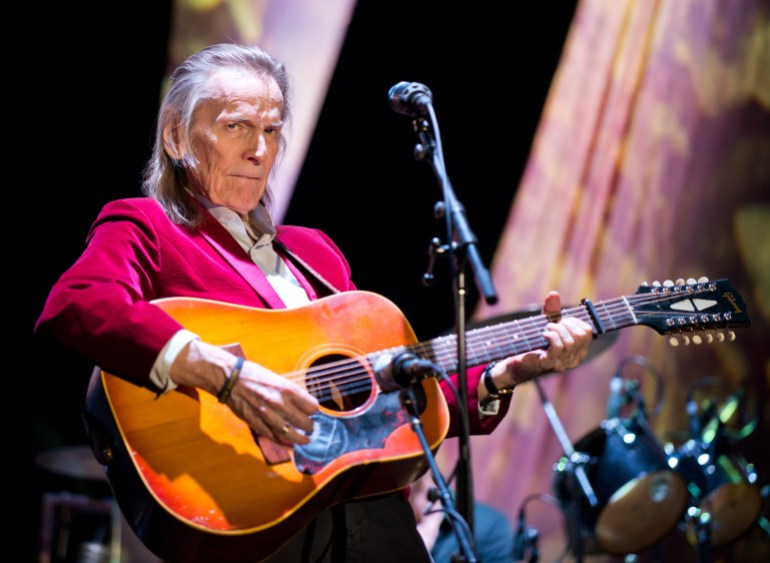His publicist Victoria Lord said the musician died on Monday at a Toronto hospital. His cause of death was not immediately available.
Lightfoot was considered one of the most renowned voices to emerge from Toronto’s Yorkville folk club scene in the 1960s. He recorded 20 studio albums and wrote hundreds of songs, including Carefree Highway, Early Morning Rain and The Wreck of the Edmund Fitzgerald.
In the 1970s, Lightfoot earned five Grammy nominations, three platinum records and nine gold records for albums and singles. He performed in more than 1,500 concerts and recorded 500 songs.
He toured late into his life. Just last month, he cancelled upcoming US and Canadian shows, citing health issues.
“We have lost one of our greatest singer-songwriters,” Prime Minister Justin Trudeau tweeted. “Gordon Lightfoot captured our country’s spirit in his music – and in doing so he helped shape Canada’s soundscape. May his music continue to inspire future generations, and may his legacy live on forever.”
Lightfoot was called a “rare talent” by Bob Dylan, and his songs have been covered by dozens of artists, including Elvis Presley, Barbra Streisand, Harry Belafonte, Johnny Cash, Anne Murray, Jane’s Addiction and Sarah McLachlan.
Most of his songs are deeply autobiographical with lyrics that probe his own experiences in a frank manner and explore issues surrounding the Canadian national identity. Canadian Railroad Trilogy depicted the construction of the railway.
“I simply write the songs about where I am and where I’m from,” he said. “I take situations and write poems about them.”
Lightfoot’s music had a style all its own. “It’s not country, not folk, not rock,” he said in a 2000 interview. Yet it has strains of all three.
The Wreck of the Edmund Fitzgerald, for instance, is a haunting tribute to the 29 men who died in the 1975 sinking of the ship in Lake Superior during a storm.
The Hula Hoop Song
While Lightfoot’s parents recognised his musical talents early, he did not set out to become a balladeer.
He began singing in his church choir and dreamed of becoming a jazz musician. At age 13, the then-soprano won a talent contest at the Kiwanis Music Festival, held at Toronto’s Massey Hall.
“I remember the thrill of being in front of the crowd,” Lightfoot said in a 2018 interview. “It was a stepping stone for me.”
The appeal of those early days stuck, and in high school, his barbershop quartet, The Collegiate Four, won a CBC talent competition. He strummed his first guitar in 1956 and began to dabble in songwriting in the months that followed. Perhaps distracted by his taste for music, he flunked algebra the first time. After taking the class again, he graduated in 1957.
By then, Lightfoot had already penned his first serious composition, The Hula Hoop Song, inspired by the toy that created a craze around the world. Attempts to sell the song went nowhere, so at 18, he headed to the United States to study music for a year. The trip was funded in part by money saved from a job delivering linens to resorts around his hometown.
Life in Hollywood was not a good fit, however, and it wasn’t long before Lightfoot returned to Canada. He moved to Toronto to pursue his musical ambitions, taking any job available, including a position at a bank before landing a job as a square dancer on CBC’s Country Hoedown programme.
His first gig was at Fran’s Restaurant, a downtown family-owned diner that warmed to his folk sensibilities. It was there he met fellow musician Ronnie Hawkins.
The singer was living with a few friends in a condemned building in Yorkville, then a bohemian area where future stars, including Neil Young and Joni Mitchell, would learn their trade at smoke-filled clubs.

Folk music boom
Lightfoot made his popular radio debut with the single (Remember Me) I’m the One in 1962, which led to a number of hit songs and partnerships with other local musicians. When he started playing the Mariposa Folk Festival in his hometown of Orillia, Ontario, that same year, Lightfoot forged a relationship that made him the festival’s most loyal returning performer.
By 1964, he was performing in front of larger and larger audiences. By the next year, Lightfoot’s song I’m Not Sayin’ was a hit in Canada, which helped spread his name in the US.
A couple of covers by other artists didn’t hurt either. Marty Robbins’s 1965 recording of Ribbon of Darkness reached number one on US country charts while Peter, Paul and Mary took Lightfoot’s composition For Lovin’ Me into the US Top 30. The song, which Dylan once said he wished he had recorded, has since been covered by hundreds of other musicians.
That summer, Lightfoot performed at the Newport Folk Festival, the same year Dylan rattled audiences when he shed his folkie persona by playing an electric guitar.
As the folk music boom came to an end in the late 1960s, Lightfoot was already making his transition to pop music with ease.
In 1971, he made his first appearance on the Billboard chart with If You Could Read My Mind. It reached number 5 and has since spawned scores of covers.
Lightfoot’s popularity peaked in the mid-1970s when both his single and album Sundown topped the Billboard charts, his first and only time doing so.
In 1986, he was inducted into the Canadian Recording Industry Hall of Fame, now the Canadian Music Hall of Fame. He received the governor general’s award in 1997 and was ushered into the Canadian Country Music Hall Of Fame in 2001.
